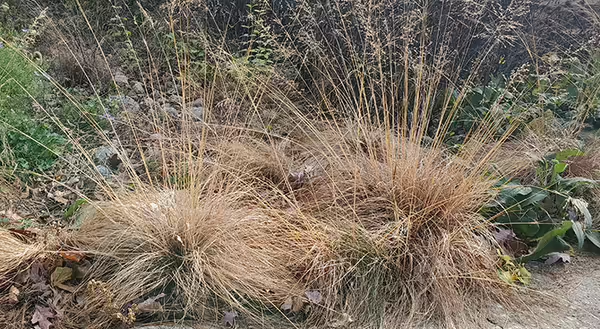
As fall progresses and most plants lose their leaves or retreat to their winter dormancy, portions of the landscape can appear bare and boring for winter. Evergreens and woody plants are commonly considered the best specimens for winter interested, providing structure throughout the seasons to stand out in winter as other plants fade. However, there are quite a few native herbaceous plants that hold their own in winter but are often overlooked.
Full Sun Plants
Native grasses are some of the best performers with respect to winter interest. Their tall stems provide vertical structure that creates a presence in the dormant landscape. Add a blanket of snow and their extreme height is further accentuated. Many gardeners have experienced the taller natives, such as big bluestem (Andropogon gerardii), switchgrass (Panicum virgatum) or even little bluestem (Schizachyrium scoparium), but there are some shorter native grasses that maintain standing stems through winter and provide some interesting texture.
Prairie dropseed (Sporobolus heterolepis) is a shorter grass, only reaching about 2-3 ft tall and that height includes its open, airy seedheads. However, the majority of its foliage and structure remain quite short, often less than 2ft. With thin, feathery leaves, it persists into spring as shorter, fine-textured puffs of grass. With a clump-forming habit, its well behaved in the landscape and can be maintained as either a specimen or in groups or rows of individual plants. Its one of my favorite natives for that space right at the edge of bed or along a walkway.
Northern sea oats (Chasmanthium latifolium) is another shorter native grass with winter appeal. Unlike prairie dropseed, it does not behave well when confined to a small bed. However, as a groundcover or in an area that needs a competitive space-filler it excels. Its broad and long leaf blades are much wider than most grasses providing a unique look. Combine the wide leaf blades with its interesting fruit structures and it creates a uniquely coarse appearance. In mass it is attractive year-round as an interesting looking ground cover. With its shorter stature, typically reaching about 3 ft, it allows for
All of the aforementioned grasses require nearly full sun, with the exception of northern sea oats that can handle some partial shade. So, be sure to place these plants in areas with ample sunlight to ensure they reach their full height in the landscape.
Shade Plants
For shady situations that need a bit of winter interest, Christmas fern (Polystichum acrostichoides) is one of my all-time favorites. It is aptly named as it retains it wonderful evergreen color throughout the winter season and certainly is a spectacular dark green at Christmas time.
Christmas fern prefers part shade to full shade locations that are fairly dry. As with most ferns it thrives in organically rich soil but to the contrary of many other native ferns, it favors well-drained, almost overly dry sites. Perhaps the biggest problem with this plant in landscape settings is crown rot from poor soil drainage, so be sure to site accordingly.
Although it is rhizomatous, this fern does not spread in the landscape and remains as individual clumps that grow in size over time to reach a height of 2-3 feet with a near equal spread.
Christmas fern works well in small groupings or as specimens plunked into the landscape in various locations to provide some winter greenery as well as summer interest from its leathery distinctive foliage. When placed at the edge of a rock wall, its spreading lance-shaped foliage appears to flow over the edge as clumps expand over time. I’ve also seen it used effectively as a mass planting on small slopes that offer a good vantage point in the landscape, which is reminisce of how it occurs naturally in woodlands.
Now is the time to take a step back and look around your landscape. Where is there a gap in the structure that some winter interest could fill? Start planning now to incorporate a few more plants next year and fill the space with subtle winter interest to break up the monotony of the dormant season.
IMAGE: Prairie dropseed is shorter native grass that nicely accentuates the edge of garden beds or walkways.